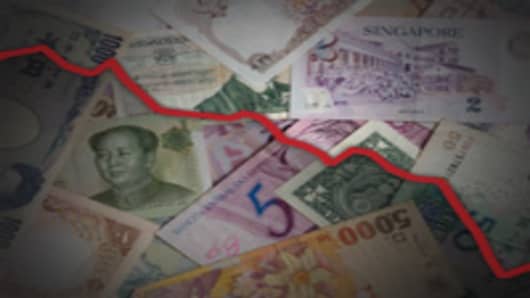Central banks around the world Wednesday cut interest rates in a coordinated move amid mounting losses on global stock markets, as the credit crunch continued to seize up lending.
The Federal Reserve lowered its federal funds rate a half a point to 1.50 percent. It also lowered its discount rate by half a point. The Fed, whose decision was unanimous, last cut rates a quarter point in April.
Central banks in the UK, European Union, Switzerland, Sweden, and Canada also trimmed lending rates.
The action is "just the kind of support the global financial markets need to bring back much needed confidence," said Bank of Tokyo-Mitsubishi economist Chris Rupkey.
The European Central Bank, which had long resisted a rate cut because of inflation concerns, trimmed its key rate by a half-point to 3.75 percent, as did the Bank of England, taking its rate to 4.5 percent.
"I hope this is enough but I wouldn't be 1oo-percent sure," said Rainer Singer of Erste Bank in Vienna. "In a normal environment, this should have been sufficient."
China essentially joined the effort, cutting its key rate 27 basis points.
The Bank of Japan, which has little if any wiggle room with rates at just 0.5 percent, did not ease but the Fed said the BOJ expressed its strong support for the coordinated policy action.
The unprecedented action comes after days of growing pressure on central banks to act together to stem mounting panic in the financial markets.
Australia cut rates a full percentage point Tuesday. Hong Kong authorities cut rates earlier in the day Wednesday.
Fed Arsenal
Fed Chairman Ben Bernanke hinted at a rate cut Tuesday in a speech in Washington.
The Fed's rate cut follows a number of extraordinary and innovative actions in recent days.
"The Fed has gone down every avenue already to add liquidity to securities firms, banks, bailouts, commercial paper market, but now it is time to bring rates down, a tried and true method to jumpstart the economy," said Rupkey.
On Tuesday, the Fed said it was creating a special facility to support the commercial paper market, used by many businesses to fund day-to-day operations. On Monday, the US central bank said it would pay interest on bank reserves. Those liquidity moves, however, did little to defrost frozen credit markets.
The central bank action comes with global stock markets trading at five-year lows, after a seemingly endless decline over the past week.
Though analysts cheered the moves, they were cautious about their effect.
"I just think that there's a sense that they keep running out of bullets," said Jim Paulson of Wells Capital Management.
"We have, in effect, passed the tipping point in terms of the financial crisis," added Don Putnam of Grail Partners
Fighting The Fight
Indeed, governments around the world appear to be throwing everything at the financial crisis.
The UK Wednesday outlined a massive bank recapitalization planmeant to shore up its ailing banking system. Priot to that, countries in Europe were bailing out banks on a case-by-case basis. (Germany appeared to rule out a UK-style plan.)
The US has been the most aggressive—and some would say innovative—in tackling the growing problem.
Perhaps the biggest step is the so-called Wall Street rescue package, a $700-billion measure signed into law by President George Bush last Friday. The legislation empowers the Treasury Department to buy depressed mortgage-based securities from financial firms in a reverse-auction process.
Bernanke and Treasury Secretary Paulson described the plan as an essential part of the recovery process because it will hopefully set a bottom for parts of the credit markets and spur new lending.
The auction process, however, is not expected to be up and running for several weeks.
In a statement, the Fed said: "Incoming economic data suggest that the pace of economic activity has slowed markedly in recent months. Moreover, the intensification of financial market turmoil is likely to exert additional restraint on spending, partly by further reducing the ability of households and businesses to obtain credit."
Robert Brusca, chief economist at Fact & Opinion Economics, said the rate cut "communicates the Fed's commitment to stimulate the economy" on top of the credit crunch.
The Fed also left the door open for additional easing, adding that it will "monitor economic and financial developments carefully and will act as needed to promote sustainable economic growth and price stability."
At 1.50 percent, the federal funds rate is at its lowest level since 2004. In 2003, the Fed pushed rates down to the historic low of 1.00 percent amid serious concern about deflation.
Though deflation is considered the worst of all economic evils, the current global credit crunch represents a threat to the global economy not seen in decades.
The bursting of previous asset bubbles—from real estate in Japan in the 1990s to the dot com phenomenon at the turn of the century—were more localized events. The credit boom and bust spread far and wide.
At the same time, economies around the world are being hit by a conventional cyclical downturn, slowing growth and trade
"We have really serious global recessionary issues that are working their way into the market," says Putnam.
(Editor's Note:This story was reported by Albert Bozzo, Christina Cheddar-Berk, Kim Khan and Antonia Oprita.)




